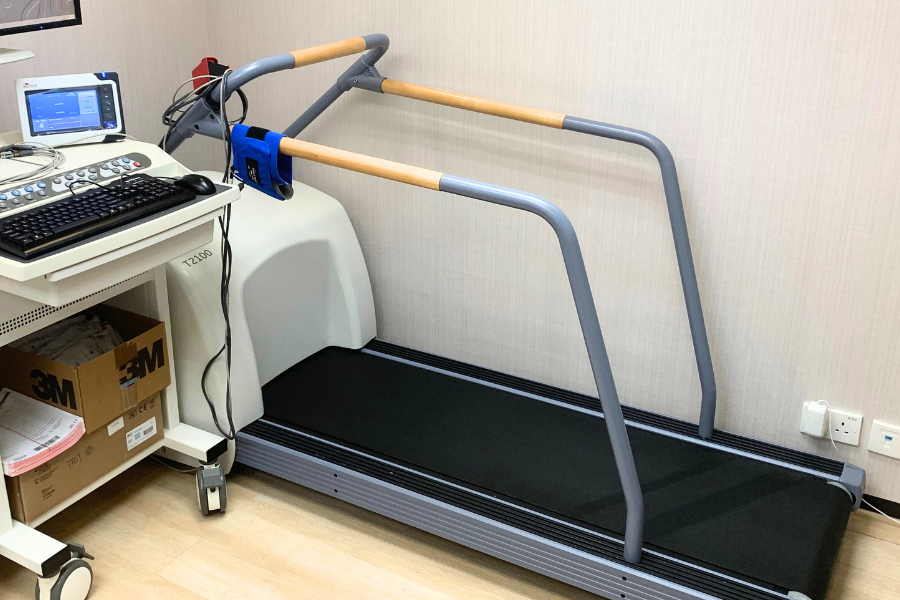
Treadmill ECG
Exercise ECG (also commonly referred to as a treadmill test) is indeed one of the commonly used methods for detecting coronary artery disease. During an exercise electrocardiogram, the person being tested walks on a motorized treadmill. The treadmill speed and incline increase every 3 minutes according to a predetermined protocol.
The purpose of an exercise ECGis to increase cardiac workload and oxygen demand in order to detect myocardial ischemia. It can reveal various heart-related issues on the electrocardiogram. During the test, the doctor monitors the participant’s real-time changes in the exercise electrocardiogram. By analyzing and evaluating the treadmill ECG, the doctor can assess the likelihood of the participant having coronary artery disease. In general, the steps involved in a treadmill ECG examination are as follows:
1. The examiner stands on the treadmill and holds on to the handrail in front.
2. The responsible medical staff will first record the patient’s complete electrocardiogram and measure their blood pressure.
3. Start treadmill examination, during which each stage will last for 3 minutes.
4. At each stage, the examiner’s electrocardiogram, heart rate and blood pressure are recorded.
5. The tester will receive blood pressure and electrocardiogram records on the treadmill until his condition returns to the level before exercise, and the entire treadmill examination will be completed.
If abnormal findings are observed in the exercise electrocardiogram or if the patient is suspected to have coronary artery disease, the test results can be used to assess the condition. If abnormal results are detected in the exercise electrocardiogram, it can help identify any symptoms or situations that may cause angina or other related symptoms. The exercise electrocardiogram can evaluate the presence of coronary artery disease or other rhythm-related cardiac issues by monitoring the patient’s heart rate and blood pressure changes during exercise.
How accurate is exercise electrocardiography?
The accuracy of exercise electrocardiogram is approximately 70%. It is important to note that the test results can have deviations, which can be categorized into two types: false positive and false negative reactions:
False positive reaction:
After performing an exercise electrocardiogram, the test result was positive, but during the actual targeted examination, it was found that the examiner’s vascular condition was basically normal.
False negative reaction:
When the tester’s blood vessels are blocked, but the exercise electrocardiogram does not show relevant results, this is a false negative reaction.
Exactly, before interpreting the results of an exercise electrocardiogram, it is crucial to consider the patient’s symptoms, signs, and other relevant clinical information, including high-risk factors. Clinical judgment should be exercised by healthcare professionals. If there are doubts or suspicions regarding the exercise electrocardiogram results, further targeted examinations should be conducted to gain a more accurate understanding of the patient’s actual cardiac and cardiovascular health condition. This may involve additional diagnostic tests, such as stress echocardiography, nuclear imaging, or coronary angiography, to provide a more comprehensive assessment.
- For those who often experience palpitations, chest tightness, difficulty breathing, etc., or those who have a family history of heart disease and cardiovascular disease, they should undergo regular exercise electrocardiogram examinations every year.
- Men over 35 years old and women over 40 years old are recommended to undergo regular exercise electrocardiogram examinations every year.
- It is recommended that the test taker does not eat too much within 1 to 2 hours before the test.
- Before the examination, remove metal objects, jewelry, and stockings or pantyhose from your body.
- During the examination, if the examiner sees an attack of angina pectoris, serious abnormal heart rhythm, high or low blood pressure, etc., the relevant examination must be stopped immediately.
- People who suffer from angina pectoris, heart failure, or very high blood pressure and severe arrhythmia are not suitable for exercise ECG examination.

